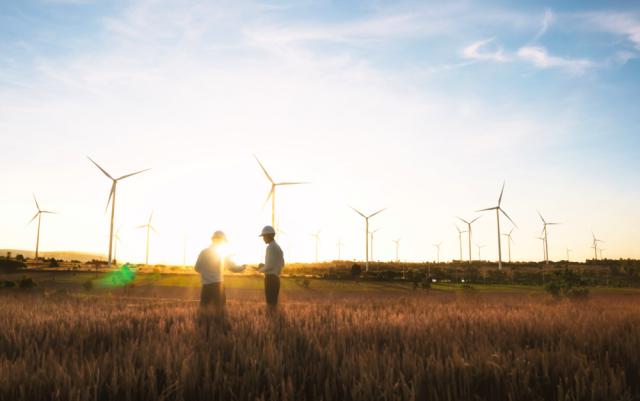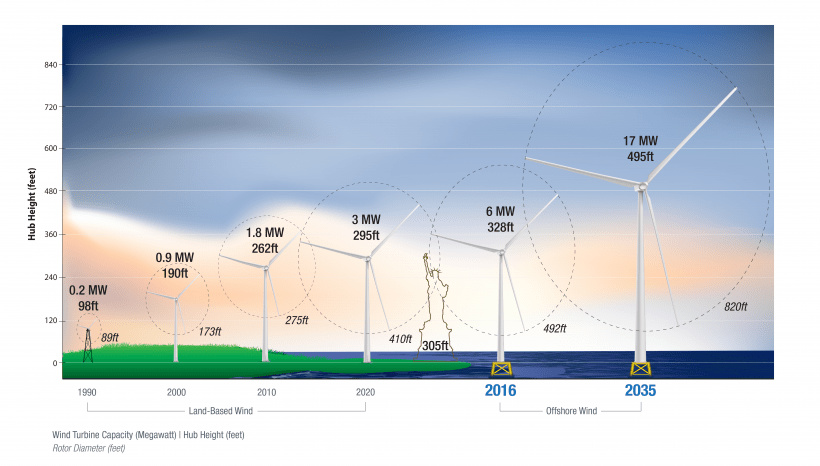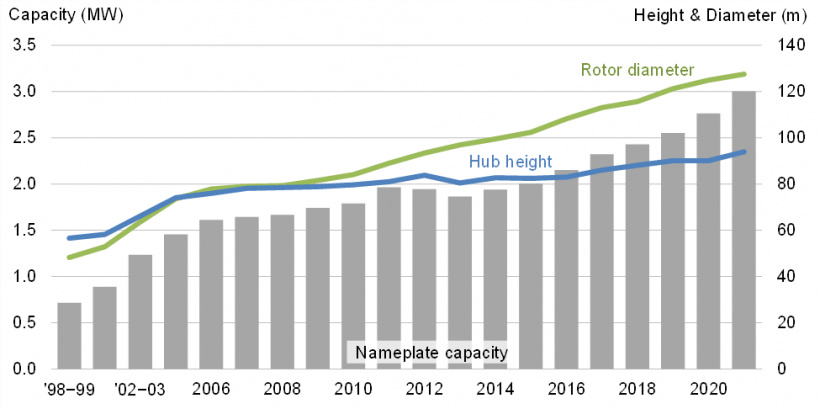
The land-based wind sector is expected to continue seeing taller turbines in the near future, according to the DOE report. (Source: Shutterstock.com)
Towering nearly as high as the Washington Monument with an average rotor diameter 12 times as tall as a telephone pole, wind turbines are getting bigger.
That could bode well when it comes to capturing more energy, considering winds typically increase as altitudes rise.
A U.S. Department of Energy report, prepared by the Lawrence Berkeley National Laboratory, shows the average tip height—from the ground to blade tip extended directly overhead—for land-based wind turbines was just under 520 ft (158 m) in 2021. That could rise to 643 ft (196 m) based on proposed turbines in the Federal Aviation Administration’s (FAA) permitting process.
“To optimize project cost and performance, and thus minimize overall cost of energy, turbines continue to grow in size,” according to the report. “The average rated [nameplate] capacity of newly installed wind turbines in the United States in 2021 was 3.0 MW, up 9% from the previous year and 319% since 1998−1999.”

The growth contributed to record production of wind power, which accounted for 32% of U.S. energy capacity growth in the 2021, the Energy Department said in August. Energy generated was enough to power 40 million homes. More than 13,400 MW of new utility-scale land-based wind generation capacity added last year, representing $20 billion in new wind power investment.
The report, part of a trilogy that included reports on offshore wind and distributed wind markets, was released as the U.S. aims to reduce emissions by turning to cleaner forms of energy. Its release also followed passage of the Inflation Reduction Act, which extends the production tax credit for wind for at least 10 years and incentivizes new wind developments and advanced technology.
“These reports show U.S. wind energy deployment and generating capacity are booming—delivering cheap, reliable and clean energy to power even more American homes and businesses,” U.S. Secretary of Energy Jennifer M. Granholm said Aug. 16. “The rapid technological and industrial advances in the domestic wind sector are creating new jobs for the clean energy workforce and assuring wind power’s critical role in achieving President Biden’s climate and decarbonization goals.”
The land-based wind sector is expected to continue seeing taller turbines in the near future, according to the report.
In the last 24 or so years, the average hub height—distance from the ground to the middle of the turbine rotor—has increased by 66%. It rose 4% in 2021 compared to a year earlier.
Jumping 164% in the last two decades, average rotor diameters also have grown significantly. Rotor diameters inched up 2% on average in 2021 to about 418 ft (127 m), allowing turbines to sweep more area to capture more wind for electricity production.
“Trends in rotor scaling in particular, but also hub height, are two of several factors impacting the project-level capacity factors,” according to the report. “The percentage of turbines with hub heights larger than 100 meters increased in 2021, to 28%—up from just 15% in 2020. Finally, the steady progression toward larger rotors continued. In 2011, no turbines employed rotors that were 115 meters [337 ft] in diameter or larger, while 89% of newly installed turbines featured such rotors in 2021 (and 23% of those were at least 130 meters).”
Longer blades enable more wind to be captured, even if the area is typically less windy, according to the Officer of Energy Efficiency & Renewable Energy.
Wind turbines are being deployed in lower wind speed areas, another tech trend highlighted in the report. In 2021, sites had an estimated average long-term wind speed of 8 meters per second at a height of 100 meters aboveground, marking the lowest average speed among new projects in the last eight years. The trend is likely to continue based on FAA and industry data for projects being developed.

“Increasing hub heights help to partially offset these trends, enabling turbines to access higher wind speeds,” the report stated.
Bigger is not necessarily always better. Transporting and installing large turbines and towers can be challenging. Research efforts are underway, however, to improve transportation limitations, targeting more slender and flexible blades and turbine towers that can be assembled onsite, according to the energy department.
Recommended Reading
Equinor Releases Overview of Share Buyback Program
2024-04-17 - Equinor said the maximum shares to be repurchased is 16.8 million, of which up to 7.4 million shares can be acquired until May 15 and up to 9.4 million shares until Jan. 15, 2025 — the program’s end date.
EQT Declares Quarterly Dividend
2024-04-18 - EQT Corp.’s dividend is payable June 1 to shareholders of record by May 8.
Will the Ends Justify the Means for W&T Offshore?
2024-03-11 - After several acquisitions toward the end of 2023, W&T Offshore executives say the offshore E&P is poised for a bounce-back year in 2024.
Kimmeridge Fast Forwards on SilverBow with Takeover Bid
2024-03-13 - Investment firm Kimmeridge Energy Management, which first asked for additional SilverBow Resources board seats, has followed up with a buyout offer. A deal would make a nearly 1 Bcfe/d Eagle Ford pureplay.
M4E Lithium Closes Funding for Brazilian Lithium Exploration
2024-03-15 - M4E’s financing package includes an equity investment, a royalty purchase and an option for a strategic offtake agreement.






